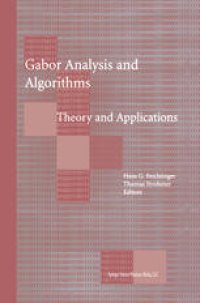
Ebook: Gabor Analysis and Algorithms: Theory and Applications
- Tags: Applications of Mathematics, Signal Image and Speech Processing, Appl.Mathematics/Computational Methods of Engineering, Functional Analysis
- Series: Applied and Numerical Harmonic Analysis
- Year: 1998
- Publisher: Birkhäuser Basel
- Edition: 1
- Language: English
- pdf
In his paper Theory of Communication [Gab46], D. Gabor proposed the use of a family of functions obtained from one Gaussian by time-and frequency shifts. Each of these is well concentrated in time and frequency; together they are meant to constitute a complete collection of building blocks into which more complicated time-depending functions can be decomposed. The application to communication proposed by Gabor was to send the coeffi cients of the decomposition into this family of a signal, rather than the signal itself. This remained a proposal-as far as I know there were no seri ous attempts to implement it for communication purposes in practice, and in fact, at the critical time-frequency density proposed originally, there is a mathematical obstruction; as was understood later, the family of shifted and modulated Gaussians spans the space of square integrable functions [BBGK71, Per71] (it even has one function to spare [BGZ75] . . . ) but it does not constitute what we now call a frame, leading to numerical insta bilities. The Balian-Low theorem (about which the reader can find more in some of the contributions in this book) and its extensions showed that a similar mishap occurs if the Gaussian is replaced by any other function that is "reasonably" smooth and localized. One is thus led naturally to considering a higher time-frequency density.
Content:
Front Matter....Pages i-xvi
Introduction....Pages 1-31
The duality condition for Weyl-Heisenberg frames....Pages 33-84
Gabor systems and the Balian-Low Theorem....Pages 85-122
A Banach space of test functions for Gabor analysis....Pages 123-170
Pseudodifferential operators, Gabor frames, and local trigonometric bases....Pages 171-192
Perturbation of frames and applications to Gabor frames....Pages 193-209
Aspects of Gabor analysis on locally compact abelian groups....Pages 211-231
Quantization of TF lattice-invariant operators on elementary LCA groups....Pages 233-266
Numerical algorithms for discrete Gabor expansions....Pages 267-294
Oversampled modulated filter banks....Pages 295-322
Adaptation of Weyl-Heisenberg frames to underspread environments....Pages 323-352
Gabor representation and signal detection....Pages 353-380
Multi-window Gabor schemes in signal and image representations....Pages 381-407
Gabor kernels for affine—invariant object recognition....Pages 409-426
Gabor’s signal expansion in optics....Pages 427-451
Back Matter....Pages 453-496
Content:
Front Matter....Pages i-xvi
Introduction....Pages 1-31
The duality condition for Weyl-Heisenberg frames....Pages 33-84
Gabor systems and the Balian-Low Theorem....Pages 85-122
A Banach space of test functions for Gabor analysis....Pages 123-170
Pseudodifferential operators, Gabor frames, and local trigonometric bases....Pages 171-192
Perturbation of frames and applications to Gabor frames....Pages 193-209
Aspects of Gabor analysis on locally compact abelian groups....Pages 211-231
Quantization of TF lattice-invariant operators on elementary LCA groups....Pages 233-266
Numerical algorithms for discrete Gabor expansions....Pages 267-294
Oversampled modulated filter banks....Pages 295-322
Adaptation of Weyl-Heisenberg frames to underspread environments....Pages 323-352
Gabor representation and signal detection....Pages 353-380
Multi-window Gabor schemes in signal and image representations....Pages 381-407
Gabor kernels for affine—invariant object recognition....Pages 409-426
Gabor’s signal expansion in optics....Pages 427-451
Back Matter....Pages 453-496
....